If you airbrush I have had good results with Vallejo model air. I use gray surface primer first. I have not tried brushing metal. Your wagon looks fantastic.
-

Win a Free Custom Engraved Brass Coin!!!
As a way to introduce our brass coins to the community, we will raffle off a free coin during the month of August. Follow link ABOVE for instructions for entering.
- Home
- Forums
- Ships of Scale Build Logs
- Super Detailing Static Models / Other Genres
- Historical Trailways, Guns, Aircraft, and Cars
You are using an out of date browser. It may not display this or other websites correctly.
You should upgrade or use an alternative browser.
You should upgrade or use an alternative browser.
Most-likely my advice will not be count... everyone (I believe everyone) on SOS knows that Jim and paint - don't go alone. However, I think you can try the canned (aerosol) paint sold in Auto shops. They have many different colors to choose from, including primer.
Thanks. Sounds like a good plan. Also thanks for the feedback.If you airbrush I have had good results with Vallejo model air. I use gray surface primer first. I have not tried brushing metal. Your wagon looks fantastic.
Thanks Jim. I think you might be being too hard on yourself. I find painting to be relaxing and yes I seem to get as much paint on myself as on my model. Makes cleanup lots of fun. It takes me back to my younger days when I painted outside in my yard and no one cared how much of a mess I made on my model cars. I find smaller brushes make less of a mess but take a bit longer.Most-likely my advice will not be count... everyone (I believe everyone) on SOS knows that Jim and paint - don't go alone. However, I think you can try the canned (aerosol) paint sold in Auto shops. They have many different colors to choose from, including primer.
The last big step in this build is the canvas top of the Wagon. The kit supplies patterns to use and cloth for the wagon top. I cut the patterns from the plan sheet and glued card stock to add some firmness. I then traced the patterns onto the cloth and cut, leaving a little extra material just in case. Before cutting a covered the cut lines with Mod Podge,which is a product that mixes water and white glue. This serves to prevent the material from fraying when cut. It works well and takes away the need to mix glue and water. I decided to leave the cloth as is instead of aging it. Next the two side panels are glued to the top using a fabric glue. Next step is to add thread to both ends of the full top and fold over the ends to form the ends of the top. The thread extends well past the ends and will be used to tie down the top to the Wagon.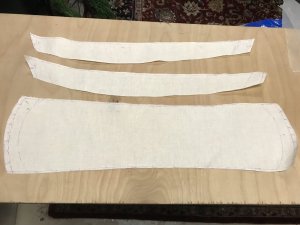

I have tried multiple times... I use to assemble plastic model ships, and one of the reasons I have stopped - is painting (the second - 1/350 scale). I don't have enough patience until it is completely dry. Paint not even on the surface strikes from the brush...you name it.I think you might be being too hard on yourself.
Today I added the canvas top to the Wagon. The top is tied down to the wagon ends by crossing the threads extending from the two sides and securing to end rods. The sides were held down by weaving the side bottoms between the top bows and wagon sides from end to end. After that I attached the undercarriage to the wagon box, added the wheels(securing them with nuts glued to the axles and added the brake lever and chain. These were the final construction steps in the build and it is now completed. I’ll put on a couple of coats of poly to protect the finishes as a last step.
A little of the background on this vehicle. While some confuse its look with “prairie schooners” it was a heavy and rather awkward working wagon designed to haul goods and materials over relatively short distances, not cross country. The driver of the wagon either walked beside it or rode on the right side horse closest to the wagon. The wagon was usually pulled by up to eight horses or twelve oxen but more ususally a team of six horses was used. It was built in and around the Conestoga river region of Lancaster County, Pennsylvania in the USA in the mid 18th Century. The horses used to pull the wagon were bred for pulling heavy loads (up to 6 tons of freight) and were called Conestoga horses, hence the name of the wagon. Conestoga horses were the first horse bred in the US. Prairie Schooners were ususally more common farm wagons with canvas tops to cover the people and goods and were smaller than Conestoga Wagons. Sadly when use of the Conestoga Wagons ceased as they were replaced by the railroads, the horse breed also died off. I hope this brief summary was enjoyable.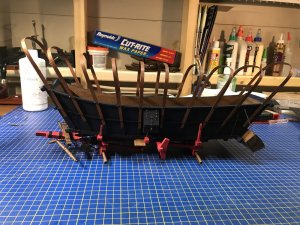
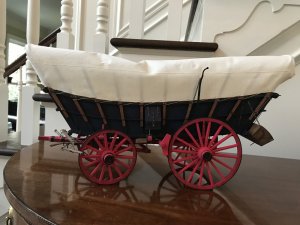
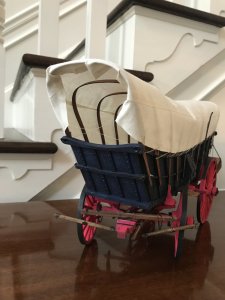
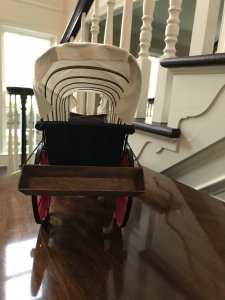
A little of the background on this vehicle. While some confuse its look with “prairie schooners” it was a heavy and rather awkward working wagon designed to haul goods and materials over relatively short distances, not cross country. The driver of the wagon either walked beside it or rode on the right side horse closest to the wagon. The wagon was usually pulled by up to eight horses or twelve oxen but more ususally a team of six horses was used. It was built in and around the Conestoga river region of Lancaster County, Pennsylvania in the USA in the mid 18th Century. The horses used to pull the wagon were bred for pulling heavy loads (up to 6 tons of freight) and were called Conestoga horses, hence the name of the wagon. Conestoga horses were the first horse bred in the US. Prairie Schooners were ususally more common farm wagons with canvas tops to cover the people and goods and were smaller than Conestoga Wagons. Sadly when use of the Conestoga Wagons ceased as they were replaced by the railroads, the horse breed also died off. I hope this brief summary was enjoyable.




Great piece of history. I had heard of the wagon but did not know that there were horses specifically bred for it. Sad to here that the bred of horses are no longer around. Also, looks like a nice job of building the model.
Thanks GrahamLooks great. You should be OK using a modelling enamel paint on metal.




